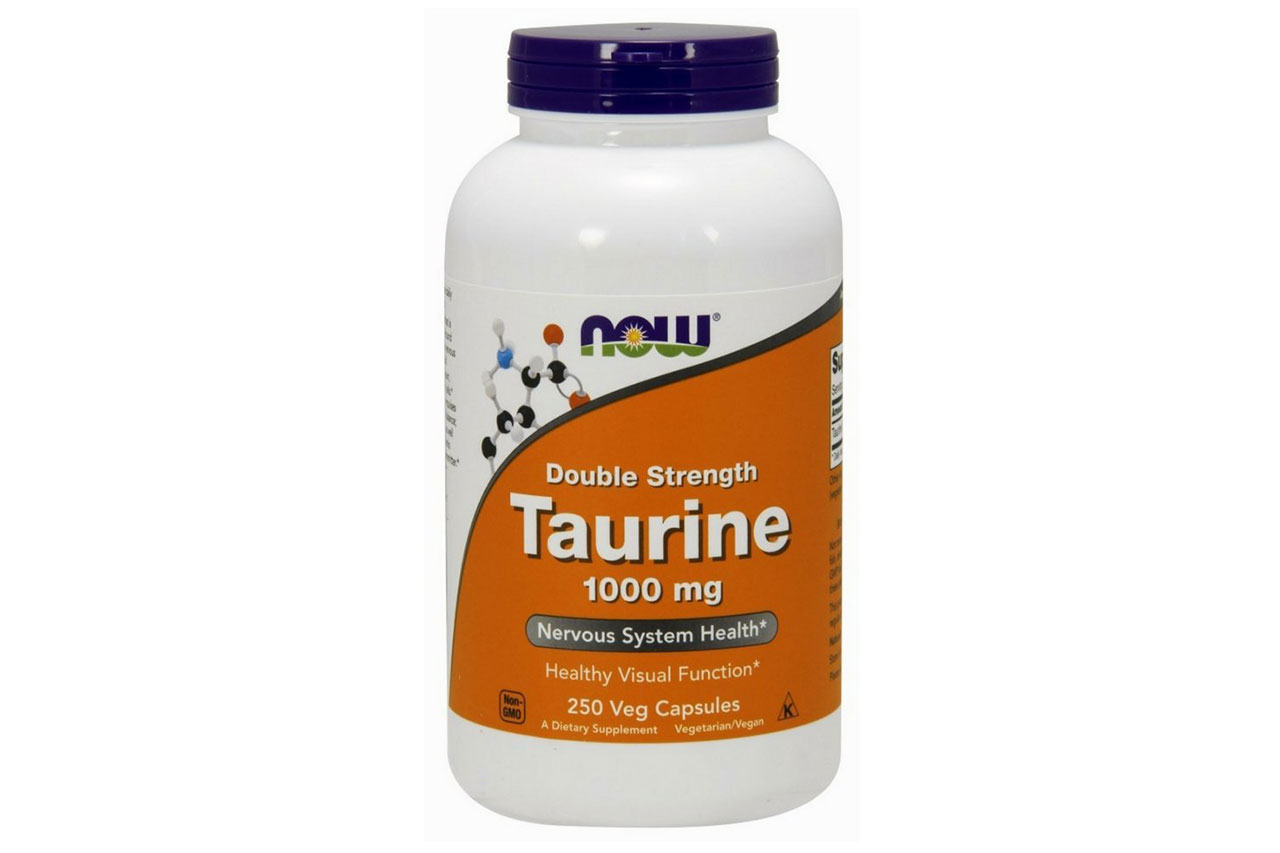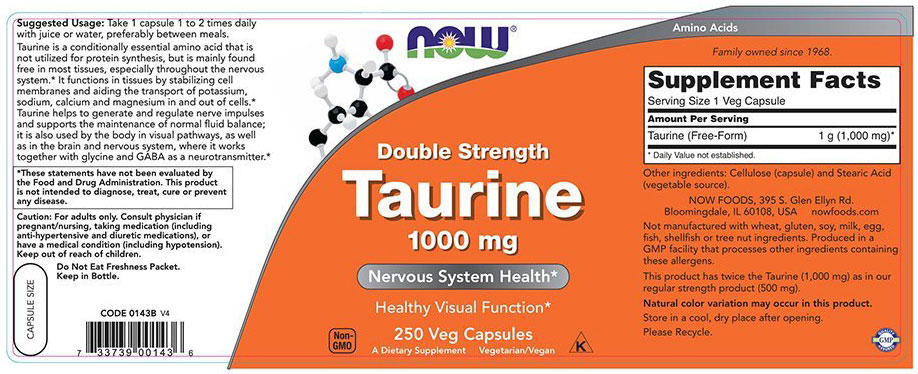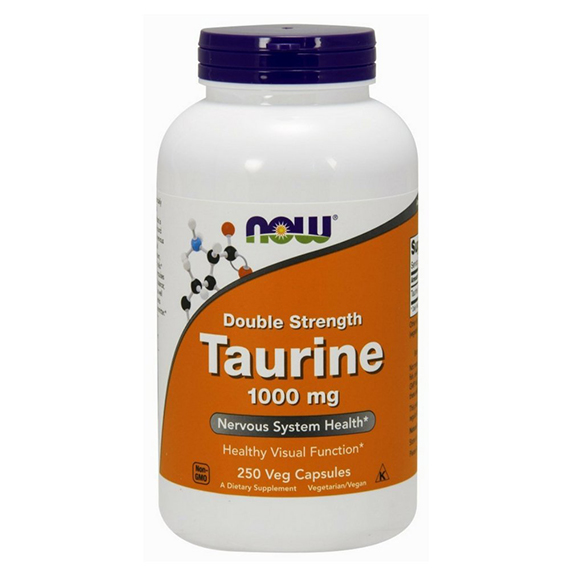Originally considered to be a simple and harmless amino acid, with no special contribution to human health, Taurine has gained a whole new reputation in recent years. From a non-essential amino acid, today the Taurine is considered conditionally essential and is being studied for the treatment and prevention of a number of serious diseases that have affected a large part of today’s population.
What is Taurine?
Taurine is a sulfur-containing beta-amino acid and is the most abundant intracellular amino acid in the human body. Unlike most other amino acids, taurine is not a structural component and is not involved in protein building.
Originally, the Taurine was derived from Ox gall. The term “Taurine” appeared in the early 19th century and its possible origin is from the Latin name for ox gall / Fel Tauri, the Greek word for bull – Tauros or the Genus Ox – Bos Taurus.
As a substance, Taurine is colorless and very well soluble in water (100 g / l).
How do we get Taurine?
We, humans get Taurine in two ways- From food or via synthesis. The main Taurine source is food, as the highest concentration is in animal products- Meat, eggs, sea food and significantly less concentrated in dairy products.
Organic, plant foods contain little to none of this amino acid. The biosynthesis of Taurine occurs mainly in the brain and the liver through a number of chemical reactions requiring three main components – the amino acids methionine and cysteine and vitamin B6.
The maximum synthesis of Taurine is still unknown, but the average amount that a healthy adult man synthesizes is between 50 and 125 mg per day. Taurine is also available as a dietary supplement and is part of most of the energy drinks on the market.
Digestion and metabolism
Orally taken taurine passes easily through the stomach and stomach acid does not cause changes in structure or quantity.
Taurine is absorbed relatively well and a peak in blood concentration is observed about an hour and a half after dosing. Eight hours after dosing the blood concentration returns to normal.
Taurine from food along with the biosynthesized one is distributed in the organism, and can be found in almost all, if not all, tissues in the body.
Highest concentrations of beta-amino acid occur in the heart, lungs, muscles, retina, spleen, brain, platelets and white blood cells. Mainly fabrics that are highly excitable and produce more free radicals.
Taurine levels in the body are mainly controlled by the kidneys through the back-up mechanism. In excess, the taurine is excreted in the urine, and in case of a deficiency it returns back to the blood.
Physiological functions
Bile juice compound
One of the well-known functions and properties of Taurine is its association with gallbladder juice.
This is extremely important for health because the compound improves the movement of bile juice and protects against Cholestasis (occlusion of bile ducts), improves the secretion of bile juice, and also protects against the toxic effect of bile acids on the liver in their secretion.
Heart function
Taurine also plays an important role in the work of the heart. At least half of the amino acid concentration in the heart is made up of Taurine, and it has been demonstrated many times how important the presence of Taurine in the cardiovascular system is.
The main mechanisms are maintaining homeostasis of calcium in the heart, maintaining water balance by stimulating Natriuretic and Diuresis in the kidneys, activating Angiogenesis (formation of new blood vessels) and weakening of the Angiotensin II hormone.
Visual function
Apart from the heart, Taurine is the most abundant amino acid in the retina. It is vital for vision and a number of experiments on animals, including primates, show degeneration of the retina and the occurrence of blindness in Taurine deficiency.
Muscle function
Taurine is also essential for the work of the muscles. This has been demonstrated in mice with a genetic deficit of Taurine. Almost complete lack of Taurine in the muscles results in 80% lower performance during physical exercise compared to a control group.
Electrolyte balance
Among the other more distinctive physiological functions of Taurine is the electrolyte balances. The presence of Taurine in cells is important for maintaining the balance of potassium, sodium, calcium and magnesium in the intracellular and extracellular space.
Protection against free radicals
Last but not least, Taurine is also a very good antioxidant. Interestingly, it is not a typical antioxidant, as its mechanism of action is rather indirect.
By deliberately reducing the levels of Taurine in the cells, it also reveals its main mechanism for fighting free radicals. Lack of Taurine hinders the construction of specific mitochondrial proteins, which in turn disrupt the operation of certain electron transport complexes.
This leads to the accumulation of large amounts of oxidants.
Taurine deficit
In healthy people, biosynthesis of Taurine should be sufficient to prevent health problems, provided enough Methionine, Cysteine and Vitamin B6 are available.
But if there is a problem with biosynthesis or the intake of Taurine through food is insufficient, it is possible that a deficiency will result and this will lead to serious consequences.
There are several groups of people in whom the risk of deficiency is high and Taurine supplementation may be of use, of course, after consulting a doctor. Premature infants have limited enzyme abilities and limited Taurine biosynthesis.
People in need of long-term parenteral nutrition are also a risky group because not many of the parenteral solutions contain Taurine and/or have insufficient cysteine.
People with impaired hepatic and/or renal function also often experience Taurine deficiency. In both cases, the problem is often in disrupted enzyme reactions that depend on these organs and are required for Taurine synthesis.
Vegans should also be careful. Although biosynthesis is sufficient in most cases because it is not a problem to get the necessary Methionine, cysteine and vitamin B6 through plant foods, it should not be forgotten that the exclusion of animal foods prevents the direct influx of Taurine from food.
Taurine as a supplement
Additional intake of Taurine at this stage is being studied in a variety of areas of human health, and perhaps the primary focus is the metabolic syndrome. At this stage, studies on humans are too few, but with animal and in vitro studies, they show a strong potential for the amino acid.
Positive results are observed in all aspects of the metabolic syndrome, but there is still much to be done in this direction. Because it is an important part of electrolyte regulation, Taurine is often helpful in the presence of cramps or nervous tics.
For sports purposes
To date, there are only two studies on the relationship between pure Taurine intake and improvement in sports results. Both are associated with a sustained aerobic load (cyclists and runners), but both do not find improvements when taking about 1.5 grams of Taurine 1-2 hours before workout.
Dosage and possible side effects
Taurine as a food supplement is safe in the doses studied so far.
Dosages of the order of 3 grams in addition to food can be taken throughout the year without the risk of health problems and side effects.
Higher doses up to 6 grams are also used in much of the research, and there are no side effects. However, there is no evidence of safety at an intake of more than a few months.



